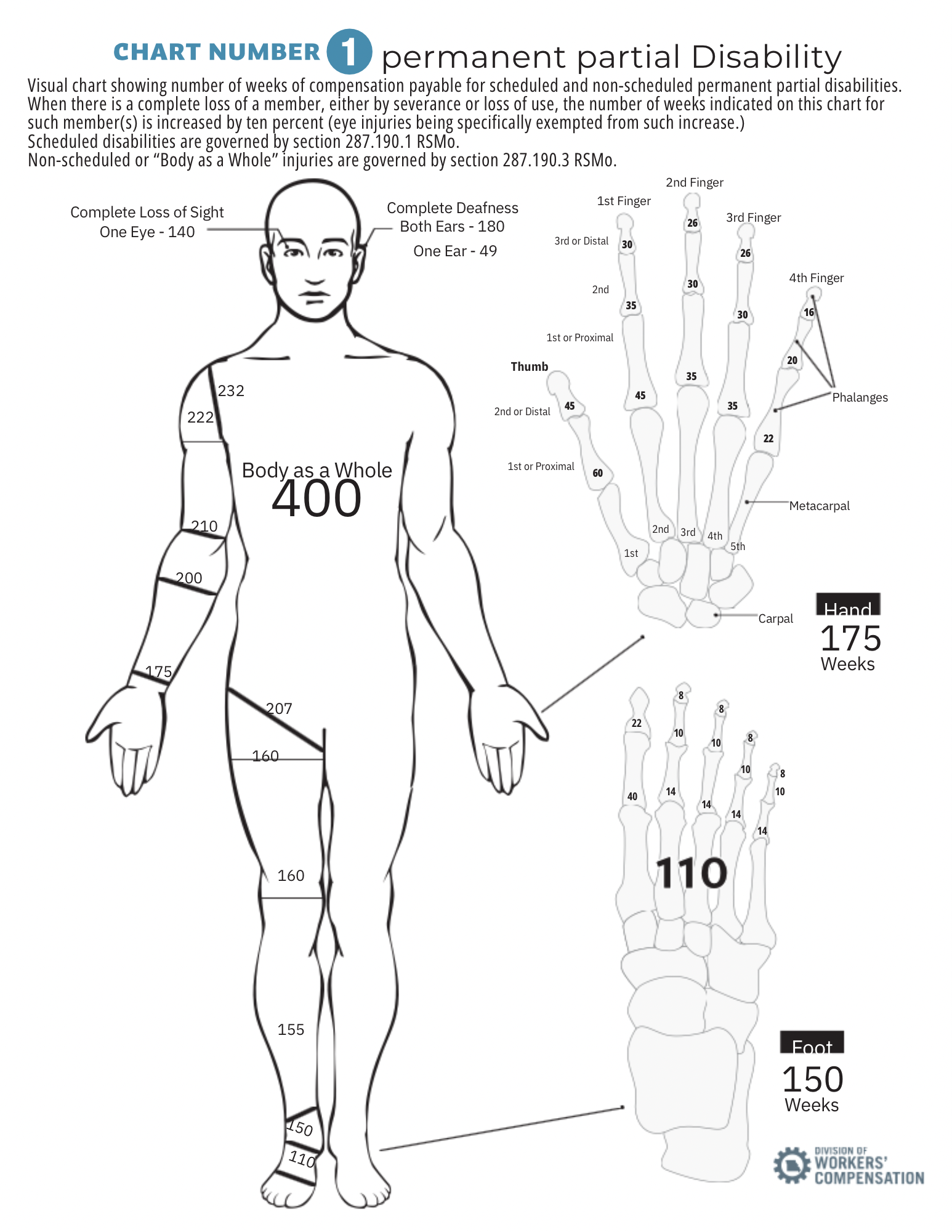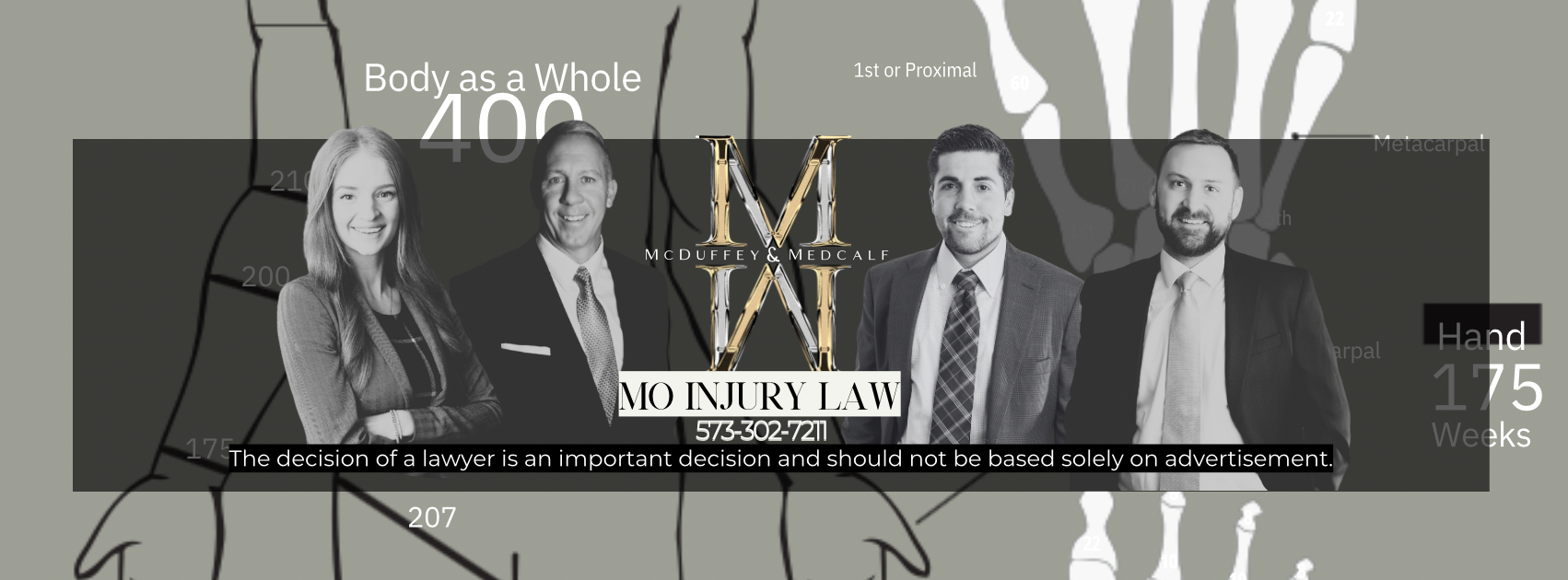
Missouri Workers’ Compensation Chart
INTERPRETING THE MISSOURI WORKERS’ COMPENSATION CHART, PART I:
What Are the ‘Little Numbers’ Stamped All Over the Body on the Work Comp Chart?
During free consultations with individuals injured while working in Missouri, or for a Missouri-based Employer, I will usually at some point evaluate the likely dollars-and-cents value of their Missouri Workers’ Compensation cases. Ahead of diving into how that works, I usually acknowledge there will be parts of the value discussion that will: “Sound odd, because they are odd“.
Since you have landed on this article, I imagine you have been trying, or you are getting started toward trying, to figure out how Missouri Workers’ Compensation cases are valued in the context of the rather “odd” chart above. Maybe, you just came for a quick glance at the chart, and it will make sense to you. That works too.
If you would like some guidance or assistance as you try and interpret the Missouri Workers’ Compensation Chart above, you may find this blog series helpful.
I am writing this blog series of articles to try and make the chart more digestible for Missouri’s workers who have no reason to have interacted with it before. In most any case, once you settle, your workers’ compensation claim is done. So, before you try to negotiate a settlement with work comp, agree to accept work comp’s settlement offer, or decide to abandon your claim; you should at least have some base of knowledge as to what you are giving up or leaving on the table if you are considering those options.
I hope you will find this series of posts empowers you to make a more informed decision on what might be best for you, your family, and your professional, vocational, and/or financial future after you have been injured at work.
THE ‘LITTLE NUMBERS’ ON THE BODY DIAGRAM OF THE MO WORK COMP CHART EXPLAINED
Those ‘little numbers’, as I frequently hear them called by clients, that are stamped onto the human body in that chart above represent a number of weeks of wages.
Yes, it is “odd” that some body parts are assigned less value than others at the outset. Yes, it is “odd” that the value is measured in wages of wages. I am often asked, “Why don’t they just do this in dollars?” Ultimately, when you understand each variable applicable to the chart, that will be the purpose or function of it all.
I like to think those who wrote the Missouri Worker’s Compensation Law (the MO State Legislature) have reasons why they assigned these starting values, measuring in weeks of wages, to Missouri’s workers’ body parts. Essentially, like with many considerations of law and/or government, the body parts each receive their value because the law ‘says-so’. There’s not much more to it than that.
Debate or discussion of whether we like, or agree with, the starting value assigned to ankle being less than a shoulder might be interesting to some, but it does not factor into the computation of your claim’s fair value within the Missouri Workers’ Compensation Chart.
That said, in this instance, why these starting values were assigned as they were is not important. There are two key things you want to focus on as you consider the function of the ‘little numbers’ in chart:
- How many weeks of wages is the body part I injured at work assigned on the chart? Write that down.
- Did I injure more one body part at work, even if during the same work incident or exposure? For each body part, write down the number of weeks of wages assigned to it on the chart.
The ‘little numbers’ on the chart are subject to very little change. People are sometimes inclined to want to fight, or negotiate everything when discussing their case. I am with you. The time will come for that part of the analysis, but in most cases, both sides will be able to identify and agree on the number on the chart corresponding to the body parts you injured at work. Do not overthink this part of the analysis.
In case you are interested how this might ever become more complicated than matching the body part to the number on the chart, one example might be: You broke some of the fingers on your hand, or one of the fingers severely. Each part of each finger is assigned its own starting value. But, what if the permanent effect is to reduce the ability of your whole hand (grip, dexterity, writing, etc.)? The insurer would likely argue the evaluation should take place at the finger-level. Can you argue instead it should be at the level of the hand? Sure.
If you fell off a ladder at work and injured your low back, shoulder, and knees, you would identify that the low back is within the 400-week-level, the shoulder at the 232-level, the right knee at the 160-level, and the left knee at the 160-level on the chart. Each will be subject to its own analysis from there. To limit yourself to only one would be a costly mistake.
So, while you now have your starting variable / number to work from within the work comp chart, you will need more information to appropriately use and understand the Missouri Workers’ Compensation Chart.
In other words, it is not as simple as: “I hurt my neck”, my neck is worth 400 weeks on the chart, this is my weekly pay-rate, and then asking for the workers’ compensation Employer/Insurer to cut you a check for 400 weeks of pay.
The other variables you will need to accurately identify and understand to complete the equation considered in the Missouri Workers’ Compensation Chart are:
– Your permanent partial disability weekly compensation rate, as defined by the Missouri Workers’ Compensation Law; and,
– The percentage of permanent disability caused by the work-injury to the body part(s) injured, which will need to be assessed by a medical professional.
Both will be individually addressed in detail in the next two parts of this series.
The series will conclude with an article with examples applying sample variables to each step learned in Parts I, II, and III.
As your knowledge of this chart grows, do not give up just because you have a preexisting injury or issue to the same area on your body. Your Employer, their Workers’ Compensation Insurance Company, and/or the doctors they send you to, will very likely make a big deal of any preexisting injury, condition, degeneration and/or arthritis. That does not mean you do not have a Missouri Workers’ Compensation Case that entitles you to work comp benefits and a settlement or recovery.
It costs you nothing to call us now and schedule a free consultation to find out if we think we can overcome your preexisting condition(s).
In case you find it helpful, I have included some terms commonly associated with work related injuries at the different levels within the Missouri Workers’ Compensation Chart.
FOR MORE INFORMATION OR CLARIFICATION:
CLICK HERE AND SUBMIT A FORM FOR A FREE CONSULT
CALL 573-302-7211 TO SCHEDULE A FREE CONSULT
EMAIL: br**@*********aw.com
400 WEEK LEVEL
Common Injuries & Terms
Neck & Cervical Spine:
C-1, C-2, C-3, C-4, C-5, C-6, and C-7 Vertebrae and/or Cervical Disc Segments, Herniated Disc, Disc Protrusion, Disc Extrusion, Cervical Instability, Spinal Cord Injury, Thecal Sac Compression, Spinal Cord Impingement, Spinal Cord Bruising, Neuroforaminal Narrowing, Foraminal Stenosis / Narrowing, Cervical Nerve Root Impingement, Radiculopathy, Pain Radiating into Upper Extremities, Numbness and Tingling into Upper Extremities (traveling down into arms, hands, and/or fingers), Weakness of the Hands and/or Arms, Cervical Spine Fracture, Fractured Vertebrae, Compression Fracture, Spondylolisthesis, Whiplash, Cervical Strain/Sprain, Annular Tear, Annular Fissure, Height-Loss, Arthroscopic Disc Surgical Repair, Non-Invasive Cervical Spine Surgery, Decompression Surgery, Cervical Disc Replacement / Arthroplasty Surgery, ACDF, Kyphoplasty, Ablation, Laminectomy, Laminotomy, Microdiscectomy, Discectomy, Hemilaminectomy, Cervical Fusion, and Multi-Level Cervical Fusion, Paralyzed by Cervical Spine Injury, Paraplegic Due to Work Injury.
Mid-Back & Thoracic Spine:
T-1, T-2, T-3, T-4, T-5, T-6, T-7, T-8, T-9, T-10, T-11, and T-12 Vertebrae and/or Thoracic Disc Segments, Herniated Disc, Disc Protrusion, Disc Extrusion, Thoracic Instability, Spinal Cord Injury, Thecal Sac Compression, Spinal Cord Impingement, Spinal Cord Bruising, Neuroforaminal Narrowing, Foraminal Stenosis / Narrowing, Thoracic Nerve Root Impingement, Radiculopathy, Bowell and Bladder Dysfunction, Radiating Pain, Radiating Numbness or Tingling, Thoracic Spine Fracture, Fractured Vertebrae, Compression Fracture, Spondylolisthesis, Thoracic Strain/Sprain, Annular Tear, Annular Fissure, Height-Loss, Arthroscopic Surgical Repair, Decompression Surgery, Non-Invasive Thoracic Spine Surgery, Spinal Cord Stimulator Implant, Thoracic Disc Replacement or Arthroplasty, Kyphoplasty, Ablation, Laminectomy, Laminotomy, Microdiscectomy, Discectomy, Hemilaminectomy, Thoracic Fusion, and Multi-Level Thoracic Fusion, Paralyzed by Thoracic Spine Injury.
Low Back & Lumbar Spine:
L1, L2, L3, L4, L5, S1, and S2 Vertebrae and/or Lumbar Disc Segments, Herniated Disc, Disc Protrusion, Disc Extrusion, Lumbar Instability, Spinal Cord Injury, Fractured Sacrum, Sacroiliac (“SI”) Joint, Sacroiliitis, Thecal Sac Compression, Sciatic Nerve Impingement or Damage, Sciatica, Spinal Cord Impingement, Neuroforaminal Narrowing, Foraminal Narrowing, Positive Straight Leg Raise Test, Nerve Impingement, Cord Bruising, Spinal Cord Injury, Radiculopathy, Radiating Pain into Buttocks, Radiating Pain into Thigh, Radiating Pain into Leg, Radiating Pain into Foot and/or Toes, Radiating Numbness or Tingling into Lower Extremities, Spine Fracture, Fractured Lumbar Vertebrae, Lumbar Compression Fracture, Spondylolisthesis, Hypertrophy, Lumbar Strain/Sprain, Annular Tear, Annular Fissure, Height-Loss, Arthroscopic Surgical Repair, Decompression Surgery, Lumbar Disc Replacement or Arthroplasty, Kyphoplasty, Ablation, Laminectomy, Laminotomy, Microdiscectomy, Discectomy, Hemilaminectomy, Lumbar Fusion, and Multi-Level Lumbar Fusion, Paralyzed from Waist Down by Lumbar Spine Injury.
Head & Brain:
Skull Fracture(s), Brain Bleed, Brain Bruise, Subdural Hematoma, Midline Shift, Craniotomy, Traumatic Brain Injury (“TBI”), TBI Resulting in Coma, Concussion, Concussion with Loss of Consciousness (“LOC”), Post-Concussion Syndrome, Headaches, Intractable Migraines, Cognitive Deficits and Dysfunction, Memory Loss, Difficulty with Focus and Attention, Difficulty Finding Words, Speech Deficits, Stuttering, Amnesia, Photophobia (light sensitivity), Phonophobia (sound sensitivity), Nausea, Dizziness, Disorientation, Psychiatric or Psychological Trauma, Depression, Anxiety, Post-Truamatic Stress Disorder, Unexplained Crying, Suicidal Thoughts, Invasive Thoughts, Nightmares, Loss of Control over Emotions like Anger and/or Sadness.
232 WEEK LEVEL
Common Injuries & Terms
Shoulder:
Rotator Cuff Injury, Rotator Cuff Rupture or Complete Tear, Partial Rotator Cuff Tear, Torn Subscapularis, Torn Supraspinatus, Torn Infraspinatus, Torn Teres Minor, Torn Labrum, Partially Torn Labrum, Biceps Tendon, Acromioclavicular “AC” Joint Impingement, Humerus Fracture(s), Humeral Head Fracture, Separated Shoulder, Broken and/or Dislocated Collar Bone / Clavicle, Scapula, Arthroscopic Surgery, Frozen Shoulder, Adhesive Capsulitis, Reverse-Total Shoulder Replacement or Arthroplasty, and Shoulder Replacement Surgery (Arthroplasty).
Note: If you injure both of your shoulders, each has its own starting value of 232 weeks in the analysis considered by the chart.
210 WEEK LEVEL
Common Injuries & Terms
Elbow:
Lateral Epicondylitis, Medial Epicondylitis, Bursitis, Elbow Sprains and Strains, Radial Head Fracture, Ulnar Head Fracture, Comminutied Elbow Fracture, Displaced Elbow Fracture, Olecranon Fractures, Distal Biceps Tendon Rupture, Posterolateral Rotatory Instability, Ulnar Collateral Ligament (“UCL”) Injury, Forearm Fractures, Pronator Syndrome, Distal Humerus Fracture, Forearm Fractures, Triceps Tendon Rupture, Annular Ligament Dislocation, Coronoid Process Fracture, Common Extensor Tendon Tear
Note: If you injure both of your elbows, each has its own starting value of 210 weeks in the analysis considered by the chart.
200 WEEK LEVEL
Common Injuries & Terms
Forearm:
Radius Fracture, Ulna Fracture, Forearm Fractures (both bones), Distal Radioulnar Joint Injury, Interosseous Membrane Injury, Essex-Lopresti Injury, Galeazzi Fracture, Monteggia Fracture, Distal Radioulnar Joint Injury, Triangular Fibrocartilage Complex Tear, Interosseous Membrane Tear, Radial Shaft Fracture, Ulnar Shaft Fracture, Greenstick Fracture, Colles’ Fracture, Smith’s Fracture, Nightstick Fracture, Radial Head Subluxation
Note: If you injure both of your forearms, each has its own starting value of 200 weeks in the analysis considered by the chart.
175 WEEK LEVEL
Common Injuries & Terms
Wrist:
Broken Wrist, Fractured Wrist, Wrist Dislocation, Comminuted Wrist Fracture, Wrist Surgery, Displaced Wrist Fracture Requiring Open Fixation with Hardware, Wrist Fusion TFCC Tear, Boxer’s Fracture, Amputation at Wrist.
Note: If you injure both of your wrists, each has its own starting value of 175 weeks in the analysis considered by the chart.
Hand:
Fractured Hand, Broken Hand, Stress Fracture, Displaced or Comminuted Hand Fracture, Metacarpal Fracture(s) or Dislocation, Hand Surgery, Hand Fracture Requiring Open Fixation with Hardware.
Note: If you injure both of your hands, each has its own starting value of 175 weeks in the analysis considered by the chart.
207 WEEK LEVEL
Common Injuries & Terms
Hip:
Femoral Head Fracture, Broken Hip, Head of the Femur, Hip Joint Injury, Hip Socket Injury, Torn Labrum in Hip, Broken Pelvis, Crushed Pelvis, Hip Flexor Tear, Hip Impingement, Hip Bursitis, Comminuted Femoral Head Fracture, Displaced Femoral Head Fracture, Femoral Neck Fracture, Intraarticular Hip Fracture, Acute Injury to Articular Cartilage of the Hip, Avascular Necrosis of the Hip, Dislocated Femoral Head, Torn Hip Ligaments, Torn Iliofemoral Ligament, Torn Ischiofemoiral Ligament, Torn Gluteus Medius, Torn Gluteus Maximus, Arthroscopic Hip Surgery, Hip Fracture requiring Open Repair with Fixation of Hardware, Total Hip Replacement Surgery (Arthroplasty).
Note: If you injure both of your hips, has its own starting value of 207 weeks in the analysis considered by the chart.
160 WEEK LEVEL
Common Injuries & Terms
Knee:
Torn Anterior Cruciate Ligament (“ACL”), Torn Lateral Collateral Ligament (“LCL”), Torn Posterior Cruciate Ligament (“PCL”), Torn Medial Collateral Ligament (“MCL”), Torn Menisci / Meniscus, Damaged Cartilage, Damage Chondral Surface, Acutely Aggravated Chondromalacia, Arthroscopic Meniscus Repair, ACL Reconstruction Surgery, Arthroscopic ACL Repair, Arthroscopic MCL Repair, Arthroscopic LCL Repair, Arthroscopic PCL repair, Viscous Supplementation Injections, Single Compartment (Uni-Compartmental) Knee Replacement Surgery, Total Knee Replacement, Tibial Plateau Fracture, Tibial Plateau Micro-Fractures, Torn Patella, Fractured Patella, Fractured Articular Surface, Displaced Patella Fractured, Displaced and Retracted Patella Fracture, Knee Surgery with Hardware, External Fixator, Knee Instability, Amputation at the Knee.
Note: If you injure both of your knees, each has its own starting value of 160 weeks in the analysis considered by the chart.
155 WEEK LEVEL
Common Injuries & Terms
Shin:
Tibia, Fibula, Calf Muscle, Tibia Fracture, Displaced Tibia Fracture, Comminuted Tibia Fracture, Dislocated Tibia with Fracture, Open Tibia Fracture (Through the Skin), Tibia Fracture Required Surgery Repair with Hardware, Non-Union of Tibia Fracture, Surgical Placement of Nail / Rod in Tibia, Fibula Fracture, Displaced / Comminuted Fibula Fracture, Open Fibula Fracture, Fibula Fracture Required Surgery, Closed Fibular Fracture, Fibula Fracture They Do Not Surgically Repair, Torn Calf Muscle, Torn Achilles Tendon, Peroneal Nerve Crush Injury, Calf Surgery, Gastrocnemius Tear, Gastrocnemius Surgery, Torn Soleus, Soleus Surgery, Torn Achilles Tendon, Achilles Tendon Surgery.
Note: If you injure both of your shins, each has its own starting value of 155 weeks in the analysis considered by the chart.
150 WEEK LEVEL
Common Injuries & Terms
Ankle:
Talus Injury, Talar Dome Injury, Calcaneus Injury, Lateral Malleolus Injury, Medial Malleolus Injury, Comminuted or Displaced Fracture, Tri-Malleolar Fracture, Torn Ankle Ligaments, Arthroscopic Repair of Talar Injury, Arthroscopic Repair of Calcaneal Injury, Arthroscopic Repair of Malleolar Injury, Broken Bones in Ankle, Ankle Surgery, Post-Traumatic Ankle Arthritis, Ankle Fracture, Ankle Fusion Surgery, Ankle Replacement Surgery, Amputation at the Ankle.
Note: If you injure both of your ankles, each has its own starting value of 150 weeks in the analysis considered by the chart.
110 WEEK LEVEL
Common Injuries & Terms
Foot:
Injury to Navicular Bone, Injury to Cuboid Bone, Injury to Cuneiform Bones, Injury to Metatarsal Bones, Broken Foot, Non-Union of Foot Fracture, Foot Surgery, Foot Surgery with Hardware, Fusion of Foot Bone, Foot Amputation.
Note: If you injure both of your knees, each has its own starting value of 160 weeks in the analysis considered by the chart.
FOR MORE INFORMATION OR CLARIFICATION:
CLICK HERE AND SUBMIT A FORM FOR A FREE CONSULT
CALL 573-302-7211 TO SCHEDULE A FREE CONSULT
EMAIL: br**@*********aw.com
The difference between what the work comp insurance companies offer, and the actual fair value of your Missouri Workers’ Compensation case, is often thousands, if not hundred-of-thousands, of dollars. Likewise, the percentage of disability you receive from the work comp doctor(s) is often much, much lower than what an appropriate and fair percentage would be; which, translates into thousands, if not hundreds-of-thousands, of dollars. A difference in your compensation weekly-rate can mean the same. If you do not factor in things like disfigurement, loading factor(s), off-work pay (“TTD”), mileage, lodging, your health insurer’s interest(s), and/or future workers’ compensation medical treatment; you could be costing yourself thousands, if not hundreds-of-thousands of dollars.
If you do not see your specific work-related injury, condition, or diagnosis; or, you are not yet sure you have one, that is okay! Reach out. We cannot know the specific facts of your case, and exactly how the law might apply to them unless you set up a free consultation for us to discuss them. If at any point in reading through this series, you decide a discussion more specific to the facts of your case would be worthwhile, please call and schedule a free phone, virtual, or in-person consultation. We have multiple office locations, and we handle personal injury and workers’ compensation claims across the entire State of Missouri.
If we can add value, we will define how within the context of what you will have learned in this workers’ compensation chart series. If we do not find it likely that you will end up with more money after our attorney fees/costs, then we will explain that we do not believe we cannot add value in that way. We have no problem explaining the value of an experienced injury or workers’ compensation attorney why that is using the same framework / variables explained in this workers’ compensation chart blog series. If we need more information before we can honestly assess your claim’s value, we will be upfront in telling you that as well. If you decide after that consult that you do not want an attorney, even if we believe we can add value, you owe us nothing. If you decide you need more time to think it over, or discuss it with family or advisors, no problem. We will not pressure you. If you decide you would like to consult with other attorneys, or that you might like a different law firm better, you can explore those options. If you make a decision to retain our law firm, we want that to be your decision, not our strong-arming you.
The choice of a lawyer is an important decision and should not be based on this blog’s information. This article is not meant to be considered, or relied upon, as legal advice. This blog is based one attorney’s experience and opinions. The opinions of other lawyers may be drastically different from my own.








